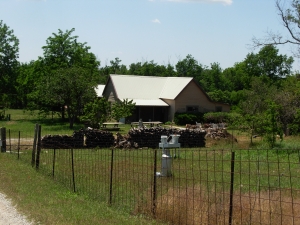The KAEFS property was originally set aside as an allotment to relocated Choctaw and Chickasaw Native American tribes from the Southeastern United States. It was first homesteaded by a Choctaw family in 1904. Their original house is incorporated into the existing farmhouse. In 1908 the family purchased an additional 32 ha. They grazed approximately 50 dairy cattle and raised cotton, broom corn, and sorghum. In 1929, a windmill run well was erected. The depression resulted in the family suffering foreclosure and loss of the land in 1932, which was subsequently sold in 1940. Shortly after this change in ownership, the East Criner oilfield was developed, part of which underlies the field station. The new family owning the farm built a new water well and a stone barn (still standing and used for storage) for their dairy operation. Given the remote nature of the farm and the poor conditions of roads at that time, maintaining a dairy was not economically feasible and the farm was sold in 1945. The new owners maintained a small dairy herd and raised cotton, grain, peanuts and watermelons on the farm and adjoining leased land and until 1968. They also constructed a number of farm ponds with the aid of the Soil Conservation Service (now the NRCS) in the 1960s.
Dr. Edwin Kessler, a meteorologist and head of the National Severe Storms Laboratory, purchased the farm in 1973 and leased it until 1976 for cattle grazing. Wheat and sorghum were raised in bottomland pastures for cattle grazing. Cattle also grazed native grasslands on the upland areas. Since 1976, approximately 12 ha of formerly tilled land have been restored to native grasslands and Dr. Kessler completed several erosion control projects including a low water crossing for Finn Creek, adding fencing to protect areas along Finn Creek from degradation by cattle, and installation of gully plugs to slow drainage into the creek. Additions to and remodeling of the original house took place in 1974. The original windmill powered well was repaired. This well together with a well south of the original house and Finn Creek provide water for the house, livestock and irrigation. The well water has high sulfate, calcium and magnesium content, however. In 1975, a new equipment shed was constructed and in 1976, a guest cottage was built. In 1984, a small office building (500 ft2) was built.Dr. Kessler has undertaken a number of agricultural projects on the farm including bee-keeping, cold-frame gardening, raising homestead poultry, and rotational cattle grazing. He maintained a small cattle herd of approximately 23 cattle on the farm through 2010, which has subsequently been sold to Ben Dixon (KAEFS Facilities Manager). The herd continues to be grazed at KAEFS as a proxy for native herbivores through a grazing lease agreement with the University.



